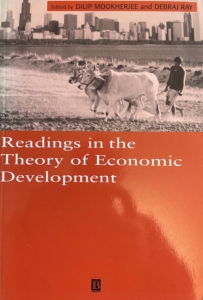(with Joan Esteban), Economics of Governance 2, 59–67, 2001.
Summary. Why is rent-seeking so endemic in societies? Might it not be possible to design a Pareto-improving social decision rule that sidesteps the inefficient waste of resources resulting from conflict? We assume that a benevolent planner knows the effectiveness of each rent-seeker, that the cost of expending resources is isoelastic, and that it is the same across all players. But she does not know the precise value of this elasticity. We show that this minimal lack of information leads to the impossibility of a Pareto-improving social decision rule, as long as there are at least four agents.
 (co-edited with Amitava Bose and Abhirup Sarkar), Oxford University Press, 2001.
(co-edited with Amitava Bose and Abhirup Sarkar), Oxford University Press, 2001. (co-edited with Dilip Mookherjee), London: Blackwell, 2000.
(co-edited with Dilip Mookherjee), London: Blackwell, 2000.